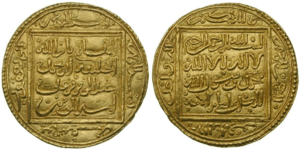Abu Yaqub Yusuf
Abu Ya`qub Yusuf or Yusuf I (Arabic: أبو يعقوب يوسف Abū Ya‘qūb Yūsuf; 1135 – 14 October 1184)[1] was the second Almohad Amir or caliph. He reigned from 1163 until 1184 in Marrakesh. He had the Giralda in Seville built as well as Koutoubia in Marrakesh and Hassan Tower in Rabat.
| Abu Yaqub Yusuf | |||||
|---|---|---|---|---|---|
| Amir al-Mu'minin; prev. amir al-muslimin (1163-1168) | |||||
 Coin minted during the reign of Abu Yaqub Yusuf | |||||
| Reign | 1163–1184 | ||||
| Predecessor | Abd al-Mu'min ibn Ali | ||||
| Successor | Abu Yusuf Yaqub al-Mansur | ||||
| Born | 1135 Tinmel | ||||
| Died | 1184 near Évora | ||||
| Burial | |||||
| |||||
| Dynasty | Almohad | ||||
| Father | Abd al-Mu'min ibn Ali | ||||
| Religion | Islam | ||||
Life
Yusuf was the son of Abd al-Mu'min, the first caliph of the Almohad dynasty. His mother was Safiyya bint Abi Imran, a masmuda woman, the daughter of Abu Imran Musa ibn Sulayman Al-kafif, a companion of Ibn tumart from Tinmel.[2][3] Like a number of Almohad rulers, Yusuf favored the Zahirite or literalist school of Muslim jurisprudence and was a religious scholar in his own right. He was said to have memorized Sahih Bukhari and Sahih Muslim, two collections of the prophet Muhammad's statements considered canonical in Sunni Islam, by heart, and was a patron of the theologians of his era.[4] Respected men of letters such as Ibn Rushd and Ibn Tufayl were entertained at his court.[5] Yusuf favored Cordoban polymath Ibn Maḍāʾ as his chief judge; during the Almohad reforms, the two oversaw the banning of any religious material written by non-Zahirites.[6] Yusuf's son al-Mansur would eventually take the reforms even further, actually burning non-Zahirite books instead of merely banning them.[7]
In 1170 he invaded Iberia, conquering al-Andalus and ravaging Valencia and Catalonia. The following year he established himself in Seville.[8] He ordered the construction of numerous buildings, such as the Alcazar, the Buhaira palace and the fortress of Alcalá de Guadaíra.
Abu Ya'qub Yusuf was wounded at the Siege of Santarém (1184), in which he died on the road to Seville, near Évora.[9] His body was sent from Seville to Tinmel where he was buried.[1]
References
- Abdelwahid al-Marrakushi "al-Mojib fi Talkhis Akhbar al-Maghrib" [The Pleasant Book in Summarizing the History of the Maghreb] (1224) pp.125-126
- Gordon, Matthew S.; Hain, Kathryn A. (2017). Concubines and Courtesans: Women and Slavery in Islamic History. Oxford University Press. p. 147. ISBN 9780190622183.
- Huici Miranda, A. (1986) [1960]. "Abū Yaʿḳūb Yūsuf". In Bearman, P.; Bianquis, Th.; Bosworth, C.E.; van Donzel, E.; Heinrichs, W.P. (eds.). Encyclopaedia of Islam. I (2nd ed.). Leiden, Netherlands: Brill Publishers. p. 162. ISBN 9004081143.
- Shawqi Daif, Introduction to Ibn Mada's Refutation of the Grammarians, pg. 5. Cairo, 1947.
- Kojiro Nakamura, "Ibn Mada's Criticism of Arab Grammarians." Orient, v. 10, pgs. 89-113. 1974
- Kees Versteegh, The Arabic Linguistic Tradition, pg. 142. Part of Landmarks in Linguistic Thought series, vol. 3. New York: Routledge, 1997. ISBN 9780415157575
- Shawqi Daif, Introduction to Ibn Mada's Refutation of the Grammarians, pg. 6. Cairo, 1947.
- "The History of the Mohammedan Dynasties in Spain," taken from Ahmed Mohammed al-Maqqari's Nafhut Tibb min Ghusn al-Andalus al-Ratib wa Tarikh Lisan ad-Din Ibn al-Khatib. Translated by Pascual de Gayangos y Arce from copies in the British Museum. Pg. 319. London: The Orientalist Translation Fund of Great Britain and Ireland. Sold by W. H. Allen Ltd and M. Duprat.
- Huici Miranda, A. (1986) [1960]. "Abū Yaʿḳūb Yūsuf". In Bearman, P.; Bianquis, Th.; Bosworth, C.E.; van Donzel, E.; Heinrichs, W.P. (eds.). Encyclopaedia of Islam. I (2nd ed.). Leiden, Netherlands: Brill Publishers. p. 161. ISBN 9004081143.
| Preceded by Abd al-Mu'min |
Almohad dynasty 1163–1184 |
Succeeded by Abu Yusuf Ya'qub al-Mansur |